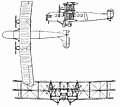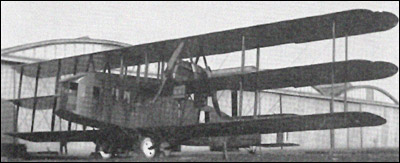|
| An unsuccessful contender for a 1917 large bomber requirement, the
Bristol Braemar triplane formed the basis of the Pullman, an equally
unwanted airliner with a large cabin and enclosed cockpit. The Pullman's
crew distrusted this feature and took to carrying axes with which to hack
their way out in an emergency. FACTS AND FIGURES © The Pullman's engines were
installed in the fuselage and ran
the propellers by cables and
pulleys. This proved its undoing as
the gear system was unworkable. © The two Braemars had an
open cockpit and gun position
in the nose, but the Pullman
had a cabin with wraparound
windscreens. The RAF test
pilots who flew it much
preferred the original layout. © The interior of the Pullman was
fitted out like a first-class
railway coach, but it never
carried a paying passenger.
 | A three-view drawing of Pullman 14 (800 x 712) |
| MODEL | Bristol Pullman |
| CREW | 2 |
| PASSENGERS | 14 |
| ENGINE | 4 x 400hp Liberty 12 inline piston engines |
| WEIGHTS |
| Take-off weight | 8059 kg | 17767 lb |
| Empty weight | 4994 kg | 11010 lb |
| DIMENSIONS |
| Wingspan | 24.89 m | 82 ft 8 in |
| Length | 15.85 m | 52 ft 0 in |
| Height | 6.10 m | 20 ft 0 in |
| Wing area | 176.98 m2 | 1905.00 sq ft |
| PERFORMANCE |
| Max. speed | 217 km/h | 135 mph |
| Ceiling | 4572 m | 15000 ft |
| Barry, 12.03.2013 13:51 You have your wires crossed regarding the Pullman and the incredibly unfeasable Bristol Tramp. The top photograph shows the Tramp which featured an internal coal fired steam engine which was supposed to drive the wing mounted propellors by, what was to become highly ineffective, wheels and pulleys. The lower photograph does show the Pullman which was a more straight forward conversion of the Braemar.However, as rightly noted none of these three aeroplanes can claim any success. reply | | Terrence I. Murphy, e-mail, 08.02.2012 22:30 If I had lived in those days, I wouldn't have flown in some of those early flying death traps, even with an axe! reply |
|
Do you have any comments?
|
| 
COMPANY
PROFILE
All the World's Rotorcraft
|








